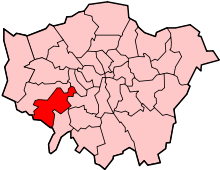GHQ Liaison Regiment
GHQ Liaison Regiment (known as Phantom) was a special reconnaissance unit first formed in 1939 during the early stages of World War II. The regiment's headquarters were at The Richmond Hill Hotel in Richmond, Surrey (now in London);[1] its base (including the officers' mess and billet) was at Pembroke Lodge, a Georgian house in Richmond Park, London.[2]
| GHQ Liaison Regiment | |
|---|---|
| Active | 1939–1945 |
| Country | |
| Branch | |
| Type | Special reconnaissance |
| Garrison/HQ | Pembroke Lodge, Richmond Park |
| Nickname(s) | "Phantom" |
| Engagements | Dunkirk evacuation Operation Overlord Operation Market Garden |
| Commanders | |
| Notable commanders | George Frederick Hopkinson Alexander (Sandy) McIntosh |
History
It had its origins as the No 3 British Air Mission in France in 1939. Moving with the Belgian General Staff, its role was to report back information about the Allied forward positions from Belgian GHQ to the Advanced Air Striking Force HQ so as to pinpoint the changing locations of "bomb lines". These were the battle areas not occupied by Allied troops, and therefore suitable targets for bombs and shells.[3]
In November 1939, Lieut-Col George Frederick ‘Hoppy’ Hopkinson was sent as a military observer to the No 3 British Air Mission and subsequently changed the method of operations to focus upon greater use of wireless communications and mobility to provide real-time assessment from the front line. The collective codename for these missions was classified by themselves as ‘Phantom’, which later became an official designation.
After the Dunkirk evacuation, the unit was re-formed as No 1 GHQ Reconnaissance Unit. As such, it was intended to have a key intelligence role following any Nazi invasion of Britain.[4] In January 1941, the Reconnaissance Corps was established and Phantom was reclassified as GHQ Liaison Regiment to avoid confusion. Phantom recruited men with various skill-sets – linguists, drivers and mechanics – and undertook rigorous training in wireless communication and cipher.
In January 1944, the Reconnaissance Corps was absorbed into the Royal Armoured Corps and with it the Phantom GHQ Liaison Regiment. Phantom was disbanded in 1945; however it was briefly reborn as the Army Phantom Signals Regiment (Princess Louise's Kensington Regiment) until 1960, when it was clear that technology provided for alternative solutions.
Operation Overlord
During Operation Overlord, in June 1944, many patrols from Phantom came to Normandy on D+1. Their task was to go around day and night to find all the British, Canadian and American units they could, marking their locations on a map, and passing the information to the main HQ.
Operation Market Garden
During Operation Market Garden, in September 1944, the only communication between the surrounded airborne troops at Arnhem and headquarters was via a Phantom patrol. This included the famous, desperate, message from General Urquhart that “... unless physical contact is made with us early 25 Sept...consider it unlikely we can hold out long enough ...” Two Phantom officers were subsequently awarded the Military Cross for maintaining these vital communications during the operation.
Phantom units also operated with XXX Corps and with General Browning whose HQ was next to 82nd Airborne HQ in Groesbeek.
Organisation
Phantom deployed in squadrons in North West Europe, South East Europe, North Africa and Italy. Each squadron supported an Army and consisted of a squadron HQ (SHQ) and a number of patrols (one per Corps and a further ten further forward of Corps). Each patrol consisted of an officer, an NCO and up to 9 other ranks. They were typically equipped with Norton motorcycles, Jeeps, Morris 15cwt trucks and White M3 A1 Scout cars and carried a 107 Receiver, 52 and 22 sets. The patrols either embedded with other formations or went on specially-directed missions from their individual Army HQs. The patrols' role was to provide collection, passage and dissemination of real-time information on the progress of battle back to Corps HQ.
For Operation Overlord, one patrol was assigned to each Divisional HQ of 1 and 30 Corps to land with Main Divisional HQ. Thus on D-Day, three Patrols (5, 8 & 14) landed with 3rd BR, 50th Northumbrian and 3rd Canadian Divisions.
Some patrols undertook parachute drops with the SAS to provide communications with SAS Brigade HQ. Later, with Phantom efficiency proven and with US forces under the leadership of 12 US Army Group, similar arrangements were made for Phantom to provide communications with US Corps.
Officers
Famous Phantom officers included: actors Major David Niven (who initially commanded A Squadron and who remarked in a letter, "these were wonderful days which I would not have missed for anything"),[5] Tam Williams and Willoughby Gray; MPs Sir Jakie Astor,[6] The Hon. Michael Astor, Peter Baker, Sir Hugh Fraser, Maurice Macmillan (Viscount Macmillan), Sir Carol Mather and Christopher Mayhew (Lord Mayhew); Law Lord Nigel Bridge, Baron Bridge of Harwich; journalist Sir Peregrine Worsthorne; and Metropolitan Police Commissioner Sir Robert Mark.[7] Others, including Sir Gordon Richards, Michael Oakeshott and John Hislop, excelled in the fields of academia, athletics and horseracing.
References
- Osborne, Mike (2011). Defending London: A Military History from Conquest to Cold War. The History Press.
- Guide to Richmond Park. Friends of Richmond Park. 2011. p. 91.
- Sampson, June. "Force of the Phantom". Kingston Guardian. Archived from the original on 25 January 2008. Retrieved 20 January 2008.
- Atkin, Malcolm (2015). Fighting Nazi Occupation: British Resistance 1939 - 1945. Barnsley: Pen and Sword. pp. 111–113. ISBN 978-1-47383-377-7.
- Day, Martyn (3 March 2011). "The Phantom in Richmond Park". St Margarets community website. Retrieved 3 October 2012.
- "Major Sir John Astor". The Daily Telegraph. 13 September 2000. Retrieved 10 February 2015.
- Duncan Campbell (1 October 2010). "Sir Robert Mark obituary". The Guardian. Retrieved 3 October 2012.
Further reading
- Niven, David (1994) [1972]. The Moon's a Balloon. Penguin Books. ISBN 978-0-14-023924-9.
- Parlour, Andy; Parlour, Sue (2003). Phantom at War: The British Army's Secret Intelligence and Communication Regiment of WWII (Hardcover). Cerberus Publishing. ISBN 978-1-84145-118-3.
